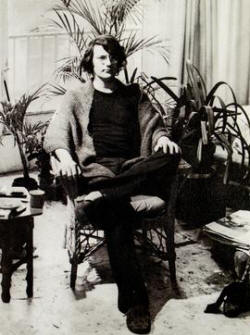

 William
R. "Bill" Sullivan (September 10, 1942 – October 23, 2010) was an American
painter, printmaker and publisher.
William
R. "Bill" Sullivan (September 10, 1942 – October 23, 2010) was an American
painter, printmaker and publisher.
Sullivan was born in New Haven, Connecticut, and died in Albany, New York. He attended Silvermine College and earned an M.F.A. from The University of Pennsylvania, where he studied with Fairfield Porter, Neil Welliver, Jane Freilicher, John Button and Rudy Burckhardt. He also studied privately with Josef and Annie Albers.
In 1957, when he was 15 years old, Sullivan was spending a summer washing dishes in Lenox, Massachusetts, and met Claes Oldenburg, who was there working at a resort and running a small gallery in a barn.[1] Oldenburg's early paintings became an inspiration for Sullivan. That fall he followed Oldenburg and his wife back to New York City, where he slept on Oldenburg's couch and camped out in Central Park. He worked as a night dishwasher at Café Figaro which, along with the San Remo Bar across the street, was a place where writers and artists congregated. Oldenburg included Sullivan's work in group shows at Judson Gallery, which he was running. Besides Oldenburg the show included Jim Dine and Red Grooms, who were unknown artists at the time.
In the late 1960s, Sullivan joined Bowery Gallery, an artist-run gallery in a storefront on Bowery that was dedicated mostly to figurative art, where he was one of the first artists to show. Later, when the Alliance of Figurative Artists was starting, Sullivan organized weekly panels and discussions at The Educational Alliance. He organized these panels on a regular basis for several years.
Sullivan's first solo show at Bowery Gallery in 1970 included paintings depicting people, New York cityscapes and still lifes. After this show, Sullivan developed an interest in landscape painting. The city of New York became one of his favorite subjects. New York City, the Hudson River and Manhattan's West Side highway became his main subjects. He had several shows of these paintings at Bowery Gallery and continued to paint the Hudson till the end of his life. At one of these shows he met art collector G. W. Einstein, who became his friend and represented him for many years. Sullivan had his first solo show at G. W. Einstein Company in 1978.
In 1977, Sullivan met the Colombian writer Jaime Manrique; they travelled to Colombia, where Bill wanted to paint the places that Frederick Edwin Church and Martin Johnson Heade had painted in the 1850s. In Colombia he had a solo show in the Bogotá Museum of Modern Art in 1978. Two years later, Sullivan returned to New York. In 1983 Sullivan travelled to Ecuador to paint the volcanoes that Frederick Church had painted. The years following is return from Ecuador were the period when Sullivan's work was most in display in New York City. Reviewing "World is Round," a group show at the Hudson River Museum, Vivien Raynor wrote in the New York Times: " Although he believes that panorama in Western art came out of a 'need to paint battles,' Bill Sullivan himself offers a view of the Palisades at sunset, which is no less engaging for being a plain old école de Hudson school landscape."[2]
In the 1990s Sullivan devoted himself to painting the landscape of New York City, in particular the skyscrapers of Midtown Manhattan, and iconic interior spaces such as Grand Central Station. In the exhibit "Paints, Props and Process" organized by Margaret Mathews-Berenson at the college of New Rochelle, which included paintings depicting Broadway theaters Sullivan showed "Moon Over St. James." Reviewing the exhibit in the New York Times, William Zimmer wrote: "Appealing in a cozy level is the painting 'Moon Over St. James' by Bill Sullivan in which a full moon and a row of theaters with their marquees lighted have a kind of equal divinity." [3]
Sullivan remained in New York City until 2001 where he had several solo shows. In 2002, he settled in Hudson, New York, where his two nineteenth-century heroes, Frederick Church and Sanford Robinson Gifford, had lived. He painted many of the sites Church and Gifford rendered on canvas. In 2006, The Albany Institute of History and Art had a major retrospective of Sullivan's work.
My published books: